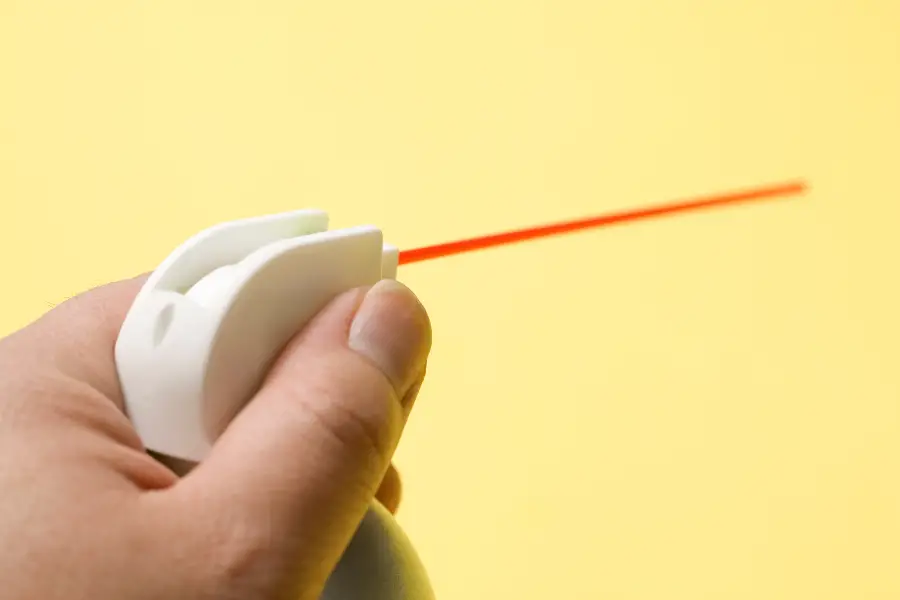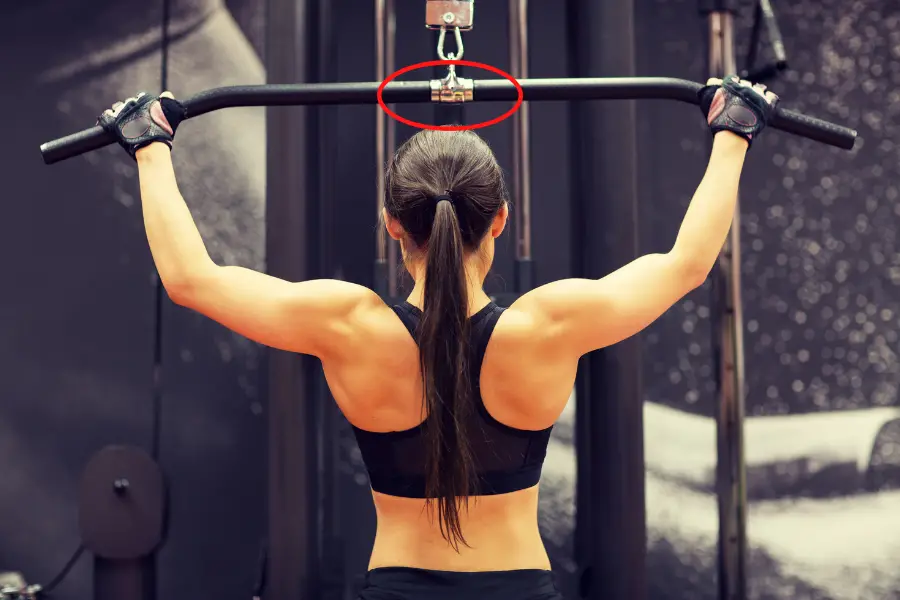Gym machines with weight stacks and cables are everywhere and they work really well for building muscle. They don’t need a ton of maintenance but some lubrication here and there helps a lot. What do you have to lubricate on your weight stack machines and how? Let’s find out.
To keep cable machines in good working order it’s best to lubricate the; 1) Guide Rods 2) Pulley rails 3) Cable attachments 4) Seat rail with a dry silicone or dry PTFE spray once a month to every other month for residential use. Cables and pulleys don’t have to be lubricated just cleaned.
Below you can find details on all the different parts. Why they should be lubricated and how to do it.
Contents
How To Lubricate Your Cable Gym Machines?
There are a few thing to lubricate regularly on a gym machine with cables and weight stacks to keep them working a smoothly as possible. The parts to lubricate are;
- Guide rods
- Pulley rails
- Pull pins
- Pivot points
- Seat rails
- Cable attachments

1. Guide rods
The guide rods are the metal rods that the weight stack slides on. These are chromed rods that go through the weight stack. They are attached to the frame at the top and the bottom and not to the weight stack. These rods help guide the weight stack straight up and down, hence the name; “guide rods”.
Most machines have two guide rods. One on either side of the cable. This keeps the plates of the weight stack balanced and prevents them from pivoting in a way that wedges the sides against the rods.
The plates of a weight stack are machined with pretty tight tolerances to make sure they fit around the guide rods. Usually the fit is pretty tight and the plates touch the rods. Depending on the machine, the hole in the weight plate can be steel or there is a little nylon/plastic insert to make sliding smoother.
Either way, some lubricant is often necessary to facilitate the rod sliding through the stack smoothly. The right lubricant Weight stack machines guide rods should be lubricated regularly to protect the rods from scratching and keep the machine working smoothly.
How?
- Clean the guide rods with a non-abrasive cloth to get rid of any dust or dirt and old lubricant.
- Inspect the rods for any damage. If there is excessive damage or scratching replacement might be necessary.
- Spray some dry silicone or PTFE lubricant on a non-abrasive cloth and rub it all over the rods. Spread it out as good as possible and before it dries.
- Spray a little bit extra lubricant around the top holes on the weight stack. Just a little is enough. No need to make a mess. Also wipe off any excess.
- Wait for the lubricant to dry and set before using the machine again.
For home gym use, doing this every month or two is sufficient.
2. Pulley rails
Many cable gym machines have adjustable pulleys. These pulleys move up and down on a rail. That rail definitely should be lubricated regularly. Just like the guide rods above, these rails are usually chromed. Chrome is a very hard material but it can scratch and deteriorate over time. The right lubricant will help prevent this from happening prematurely.
Often times the pulleys can become hard to adjust up and/or down. That’s a clear sign the rails are too dry. You should try to avoid that movement getting tougher and apply lubricant before to prevent any damage.
How?
Pulley rails should be treated in the same way as the guide rods. Use a dry silicone or PTFE lubricant. The same steps as for the guide rods can be used here. Just make sure to get the part under the pulley as well by moving it around a little.

3. Pivot points
Any pivot points of a cable gym machine should be lubricated according to manufacturer’s guidelines. Some of these pivot points have sealed bearings so there is not much to be done while others need to be greased regularly. Read the manual of contact the manufacturer for exact guidelines.
Suggested: 3 Best wall mounted pulley systems
4. Cable Attachments
The cable attachments aren’t really part of the machine but you kind of need them to use many of them properly. Any cable attachments that have two moving parts that are both made from metal should be lubricated regularly. Without lubrication these parts start squeaking and rotate in a very jerky motion. This is one of those things that is very easy to prevent.
With metal cable attachments, lubricate from the beginning and not just when it starts making noises and getting stuck. Dry metal on metal contact will damage the surfaces pretty quickly.
Common cable attachments that need this type of attention are metal D handles and straight/lat bars with a single eyelet in the middle.

How?
It’s impossible to get the lubricant into these small spaces with a cloth. Thin spray lubricant is the easiest to get in there because it will trickle down. WD-40 or similar is great at penetrating deeply into hard to reach areas. The problem with WD-40 is that it’s not all that great at lubricating. So if you use it, use it often. Silicone or PTFE spray lasts longer. Of those two, silicone is the easiest to get in there.
Make sure to wipe off any excess lubricant that drips out the other end or got onto the grips. A slippery cable attachment is about as irritating as a squeaky one.
Suggested: 5 Essential cable attachments
5. Seat adjustment rail
Some seats are adjustable in height because there are two metal tubes sliding inside of each other. Metal on metal contact should always be lubricated to keep everything moving freely and smooth.
Seat adjustments that work with a kind of ratchet system often don’t need any attention.
How?
The same Silicone or PTFE sprays recommended above will work for the seat adjustment rails. However the procedure is slightly different;
- If possible, take the seat out completely. If not possible, put the seat in the highest position.
- Clean the exposed metal with a non-abrasive cloth.
- Spray some silicone or PTFE spray on a non-abrasive cloth and spread it out over the metal rod.
- Wait for the lubricant to dry. In the meantime, take the opportunity to take care of the pull pin.
- Put the seat back into the machine or return to the normal position.
So the procedure is pretty much the same as for the guide rods and pulley rails but you’ll have to take out the seat first and it’s a good idea to lubricate the pull pin at the same time.
Best Lubricant For Gym Cable Machines
Before we get to how to lubricate the correct parts, it’s important to know what the best lubricant to use is. Not every lubricant works well for every part so it’s definitely worth getting the right one(s).
For gym equipment with a weight stack and cables, a dry silicone or PTFE spray is the best option. These provide the best protection and lubrication without attracting too much dust or damaging surfaces. A spray can is much easier than a tub because a straw is much easier to get into small spots where you might not be able to get a finger.
WD-40 is something everyone has around the house but it’s not the best option. WD-40 is a water displacement formula that’s also a good solvent and corrosion protection and can loosen things that Thor couldn’t move before. But it’s not actually that good at lubricating.
You might also have a tub of grease somewhere. Don’t use this, especially not for the guide rods and pulley rails. It makes a mess and just attracts dirt you’ll have to clean up later. It’s also difficult to apply grease thin enough.
Suggested: How to lubricate an exercise bike?
What Doesn’t Have To Be Lubricated on Gym Equipment?
Did you expect some items on the list above that are missing? Some things on a cable machine you expect to have to be greased don’t actually need it. Here’s what you don’t have to lubricate.
Pulleys and cables
Contrary to what might seem obvious, you shouldn’t lubricate the cables and pulleys of gym equipment with a weight stack. The pulleys and cables should be cleaned and kept free of dust and dirt to keep them rotating freely.
Suggested: How to maintain gym machine pulleys
There is very little friction between the cable and the pulley wheel because the wheel should rotate with the movement of the cable. If it doesn’t, there’s likely debris blocking the movement somewhere. The bearings in the pulleys are sealed and should last a long time. Because they’re sealed, applying lubricant to the outside won’t do anything. Sealed bearings are not meant to be re-greased although it’s possible. However, usually a worn out bearing means that you should replace the whole pulley. The same goes for cables.
Suggested: Can you replace cables on a gym machine?
Selector pin
The selector pin is the little pin you use to put in the different holes of the weight stack. The pin goes through the weight plate and into a hole on the selector rod. The selector rod is connected to the cable.
The selector pin doesn’t have to be lubricated, just make sure it’s clean and straight. A pin with dirt caked on or one which is slightly bent can cause problems.
If it doesn’t want to fully or smoothly push through the plate into the selector rod, it’s more likely there is an issue with the alignment between the holes in the weight stack and the holes in the selector rod. Alternatively it’s possible that there isn’t enough slack in the cable so the selector rod doesn’t go down far enough to release all the tension on the pin. Lubrication won’t fix either of those problems.
Suggested: How to add weight to a gym machine weight stack
Another issue could be dirt and debris building up in the holes. That could obviously prevent the pin from getting through easily. If some holes are smoother than others, give the problematic ones a visual inspection to see if there’s anything to clean.
Higher quality machines often have a much better feeling action on pushing the pin in and out because those machines are made to tighter tolerances and everything just fits together better. On a lower quality machine where things are impossible to get aligned perfectly a tiny bit of lubricant might help but in that case it’s a band aid and not a solution.
Selector rod
The selector rod is the rod in the middle of the stack the selector pin goes through and so picks up the weight. The hole for this rod is usually quite a bit larger than the ones for the guide rods and the selector rod rarely touched the plates. If it does, the selector rod might be damaged or something about the alignment of the stack is off.
Because it doesn’t touch anything except the selector pin, it doesn’t have to be lubricated. Just keep it clean and prevent any buildup of grime in the holes.

